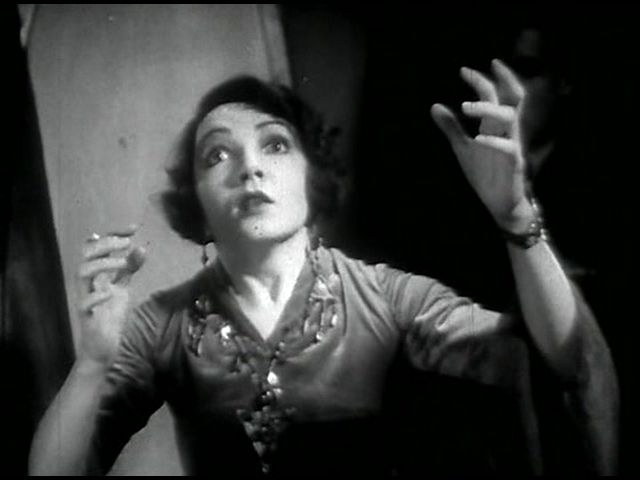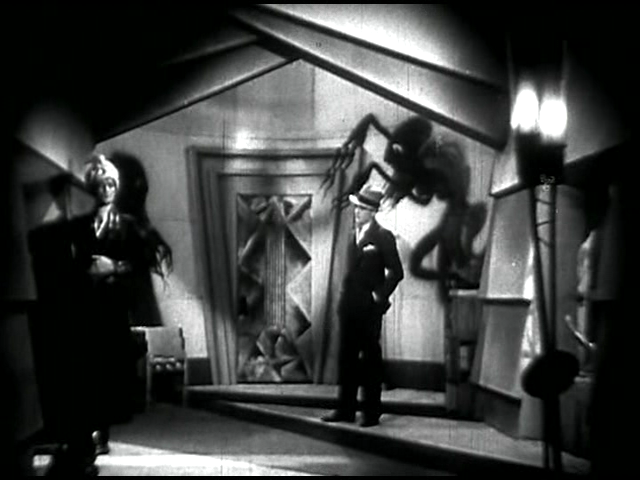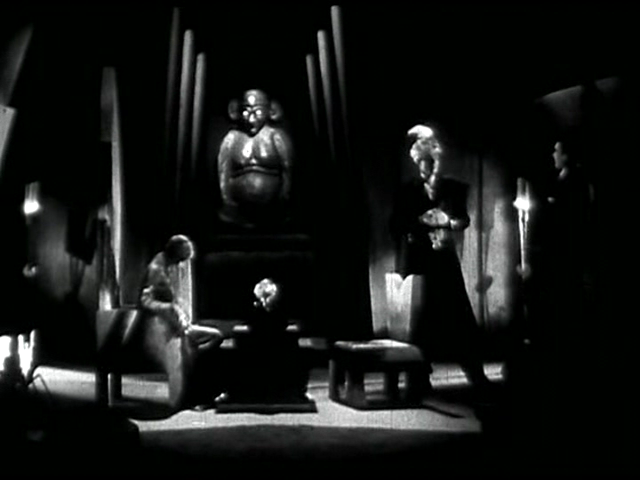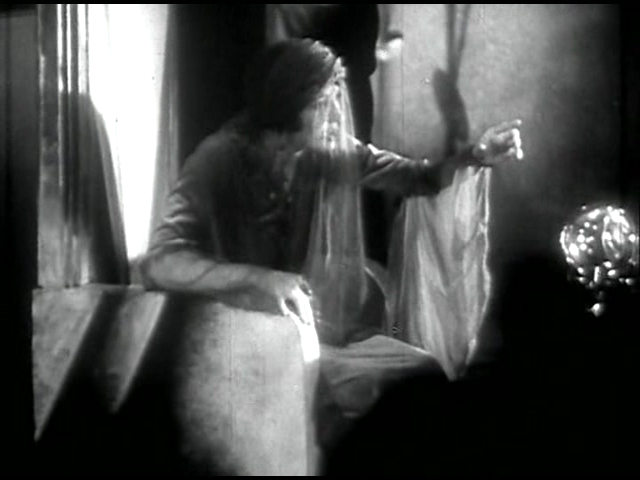
Watching a Hollywood movie from 1929 is like watching a Hollywood movie from 1932 played underwater. Society hadn't been revolutionized much in those few years, so the movies often have the same concerns, the same good guys and bad guys, laugh at the same things, fear the same things. But the very early talkies are famously sslllooooowwwww —words like "stilted" get bandied about a lot. The microphone dangled over the actors like a sword of Damocles, terrifying silent-trained thesps like Clara Bow, or else it lurked, concealed in a bush like an armed bandit, compelling the cast to adopt frozen postures so they could communicate with it.
Who invented fast talking? It's something we take for granted in thirties movies. You wonder, "How did they avoid tripping over their lines, when they talk so fast?" and then you see some Warner Bros. blooper reels and realize they didn't, always: scene after scene of Pat O'Brien or Edward G. Robinson fluffing, choking, corpsing or cursing. It seems as if the rapid-fire approach was a deliberate overreaction to the inertia of early sound drama. The slow enunciation favored by sound men and dialogue coaches wasn't working: scenes frosted over in a glacial creep of exposition. Pauses weren't working: the tension seemed to slip away whenever the jabber let up. So blitz the audience with savage verbiage, don't pause for breath and maybe they won't either.
So it's a dreamlike experience to see Robert Florey's The Hole in the Wall, Eddie G. Robinson's first talkie, where he plays a prototype of the tinpot Caesars he'd make his name with, but at one tenth the speed and one half the volume. He does get to snarl "Nyeeeah?" though.

Robinson's gang work with a fake medium, Madame Mystera, ripping off the rich and gullible, not just with palmistry but burglary to boot. When Madame M. is torched in an L-train crash (hilarious toy train shot capped with expressionist montage of slain commuters), the team recruit jailbird Claudette Colbert as replacement, falling in readily with her scheme to kidnap the infant grand-daughter of the society lady who got her banged up. Throw in a slow-talking investigative reporter (smirking scenery-blocker David Newell, working his way down to background artist), stir, and sit back to watch the thing coagulate.
At the helm is Robert Florey, fresh from a series of extraordinary short films (The Love of Zero, The Life and Death of 9413, A Hollywood Extra) made in collaboration with rogue talents such as Slavko Vorkapich, William Cameron Menzies and Gregg Toland. Thrust into the new medium of talking pictures, Florey gamely shot four features in a year, including The Coconuts, which introduced the Marx Bothers to the movies and which consequently moves at a faster lick than this one, although Groucho et al do seem to be dragging the whole studio behind them. The Hole in the Wall stands as a bridge between the expressionism of the brilliant shorts and the stylish, energetic B-movies Florey would make for off-beat talents like Peter Lorre and Anna May Wong.

The set is the thing here: no credit for production designer is given, but the crazyhouse temple out of which Robinson's gang operate smacks of Menzies' brand of jumbled orientalism: a mad network of clashing metallic angles, surmounted by a sinister Buddha with glow-in-the-dark eyes. Florey tends to frame for the backdrops rather than the action, so the dramatic tension falls through the cracks like dropped peanuts, but many of the images glow black with oneiric romance.

The Fox; Goofy; Madame Mystera—those were the days when gangsters had gangster names. There's even a hopped-up carnival geek called Dogface, a member of the mob despite his inability to perform any useful function, unless insane cackling is useful. Mild-mannered Donald Meek as Goofy makes a surprisingly sappy outlaw, subtracting further from what should the film's crackling dynamism. Moving in short bursts of implausible plotting, the film comes to life when strange things happen: short scenes are presented without any sound at all, a few shots are snatched on a real L-train, and in one extraordinary scene, Claudette Colbert attempts to run her lines with an excitable Marcia Kagno, the tiny child her character's supposed to have abducted. Since Kagno never stops chattering adorably, the resulting scene is one of the few to build immediately upon Al Jolson's improvised speech in The Jazz Singer, while simultaneously inventing the art of overlapping dialogue: although, without the careful planning of a Hawks or Welles, we end up with an aural muddle more akin to Altman at his most adventurous.
The plot has one more trick up its sleeve, when Claudette suddenly finds herself gifted with authentic psychic powers, allowing her to tip off the cops when little Marcia is in danger. Communicating via a dubbed spectral voice, exactly like the medium in Kurosawa's Rashomon, she has her strongest moment as actor (she's consistently good in this, actually), and anticipates such diverse pleasures as the ending of Hitchcock's Family Plot, and the supernatural-gangster crossover of The Walking Dead. It turns out that the title refers not to an underground gang, but to the gap between this world and the next, through which, like Pyramus to Thisbe, the departed may occasionally whisper, through the courtesy of the MovieTone sound-on-film system.

The great American features of 1929 were mostly silents: Borzage's The River and Stroheim's Queen Kelly, for instance. But audiences, either through indulgence or sheer bad taste, welcomed the clunking newborn that was the talking picture, and in The Hole in the Wall we can hear the infant medium's first tentative gurgles.
***
The Forgotten is a regular Thursday column by David Cairns, author of Shadowplay.